The mediaeval ruin of Saint Andrews Cathedral is located in the historic coastal town of St. Andrews. The cathedral is best known for the thirty-three-metre-tall St. Rules Tower, which dominates the coastline in this picturesque part of Fife. Discover everything you need to know about St. Andrews Cathedral with this guide, which includes an overview and helpful visiting advice.

| Address: | The Pends, St Andrews, Fife, KY16 9QL |
| Opening Hours: | 1 April to 30 September Daily 9.30 am to 5.30 pm (last entry 5 pm) 1 October to 31 March, Daily 10 am to 4 pm (last entry 3:30 pm) Closed 25th, 26th December and 1st, 2nd January |
| Admission Price: | Adult (16-64yrs) £6.00 Concession (65yrs+ and unemployed) £4.80 Child (5-15yrs) £3.60 Family (1 adult, 2 children) £9.50 Family (2 adults, 2 children) £14.00 Family (2 adults, 3 children) £16.00 |
| Parking: | No on-site parking. Car parks in St. Andrews. |
| Contact: | 01334 472 563 |
| Facilities: | Gift shop, water refill |
Overview
If you ever find yourself in the picturesque coastal town of Saint Andrews, you might like to take a short walk to the ruins of the mediaeval cathedral located close to the town centre. This enormous complex of derelict walls, gravestones, and foundation stones was once the heart of the Catholic Church in Scotland, but it’s now more famous for St. Rules Tower, the 33-metre landmark that can be seen for miles around, offering stunning views across St. Andrews.
Historic Environment Scotland (HES), which is in charge of managing the site, keeps the ruins in good condition and offers ticketed visitor access. Families can enjoy exploring the mediaeval nooks and crannies hidden away amongst the church walls and graveyard, as well as learning about the history of the cathedral thanks to the small museum on the site.
The fact that this attraction lies so close to the town centre also means you’ll have plenty of time to explore St. Andrews after your visit, and you can let the kids run riot on the sandy beaches nearby.
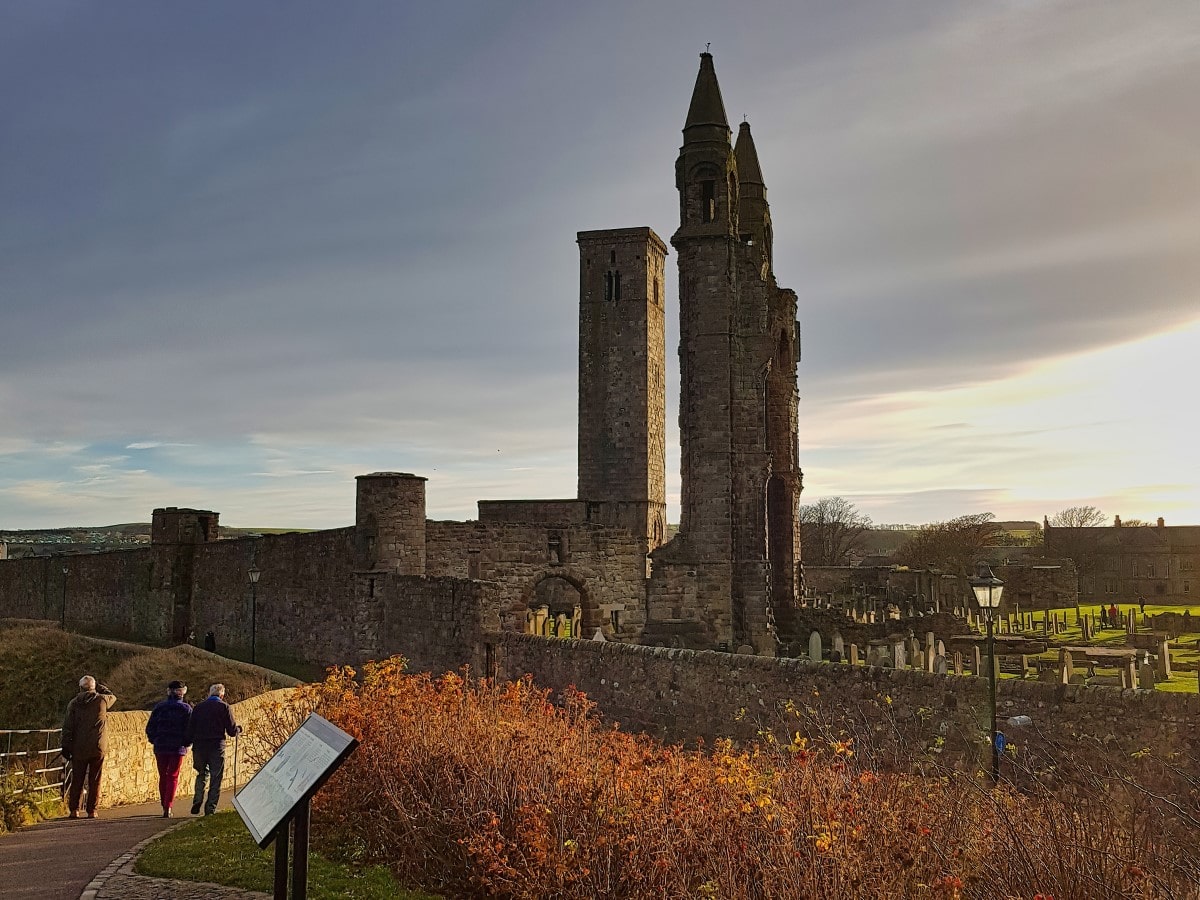
Book Tours in Scotland
The Highlights
1: St. Andrew’s Cathedral is the largest and one of the most important mediaeval cathedrals in Scotland. It was built in 1158 and served as the centre of the Scottish Catholic Church until the Reformation. The cathedral is now in ruins, but it still retains its grandeur and historical significance.
2: The cathedral is located in a beautiful coastal town, offering stunning views of the North Sea. Climbing to the top of St. Rule’s Tower, which is part of the cathedral grounds, provides a panoramic view of the town and the coastline.
3: The museum houses a collection of mediaeval sculptures, grave slabs, and other artefacts found during excavations. It provides an insight into the religious and cultural history of Scotland during the Middle Ages.
Visiting Tips
1: Have a look around Saint Andrews after you’ve visited the cathedral. It’s a lovely town (especially if you’re a golfer) that’s full of artisan cafes and gift shops.
2: If you want to visit a nearby family attraction, take a look at St. Andrews Aquarium which offers a wonderful day out for all ages. Another animal-themed attraction that’s a bit further to the west of St. Andrews is the Scottish Deer Centre which is one of the best child-friendly places to take kids in the east of Scotland.
3: Visitors often forget that the city of Dundee is a mere 30 minutes away on the A91. While you’re there, I recommend you check out the V&A Museum and the McManus Museum – both of which are free to enter and offer a good few hours of exploring.
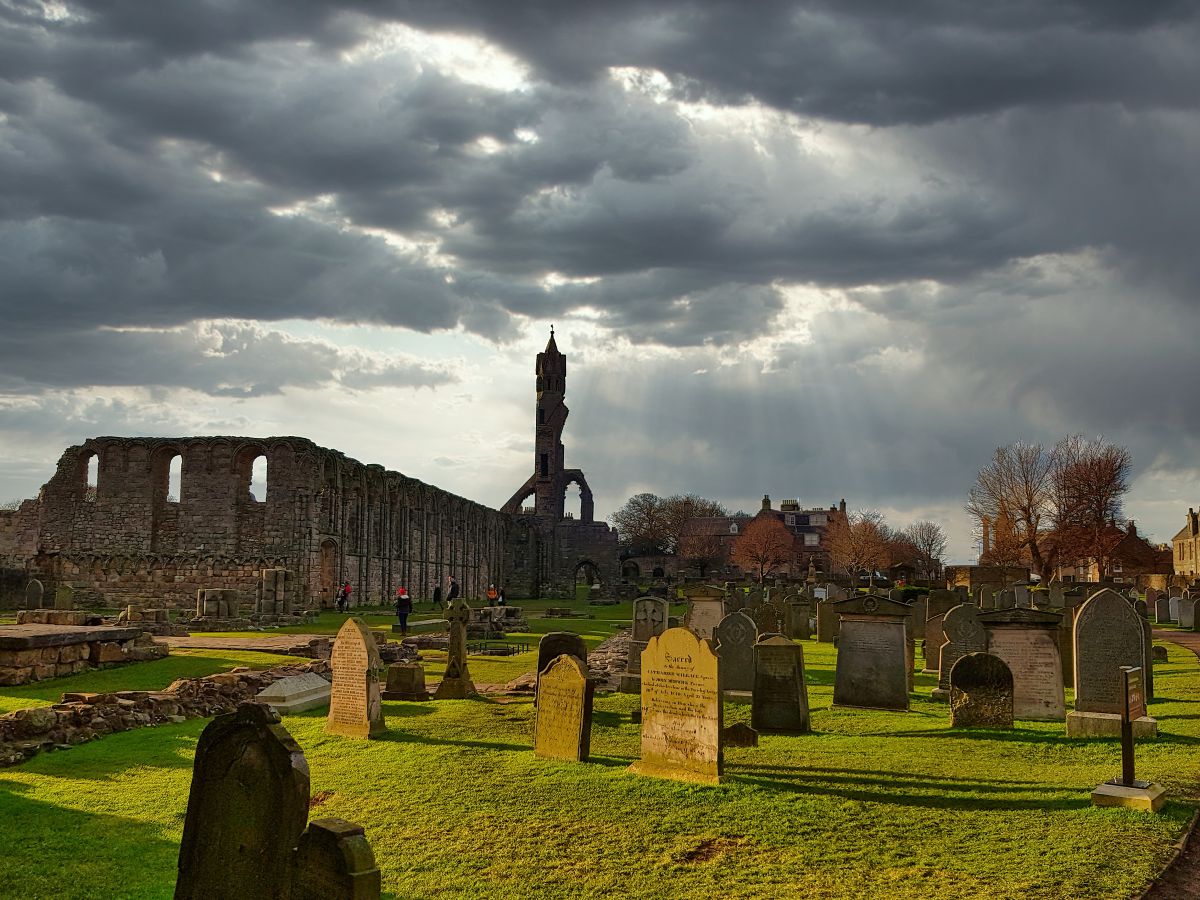
Protect Your Family From Scotland's Biting Midges
- Powerful, reliable protection for up to 8 hours
- Water- and sweat resistant
- Repels midges, mosquitoes, horse flies, sand flies, fleas and ticks
- Safe for use on adults, children over 30 months and pregnant women
- Non-sticky, moisturising with a pleasant fragrance
- Packaging may vary
Tourist Information
The town of St. Andrews has become increasingly popular with tourists in recent years, and for good reason. First, there’s the world-class golf course which overlooks the seafront and is believed to be the oldest in the world. It’s at this course that historians believe golf was invented, and it’s known that the game has been played at St. Andrews Links for at least 600 years.
Second, the charming town centre features dozens of quality restaurants and craft shops, as well as the famous St. Andrews University. Third, the town is home to St. Andrews Cathedral, which at one time was one of the most important buildings in Scotland.
Walking through the cathedral’s enormous graveyard, you begin to get an idea of how big the main building must have been in its prime, which is easier to understand if you trace the route along the 119-metre length of the remaining foundation stones.
This huge cathedral was obviously built to impress, and it still does – even if most of the walls are in ruin – but there’s another more intact religious feature that’s even more impressive.
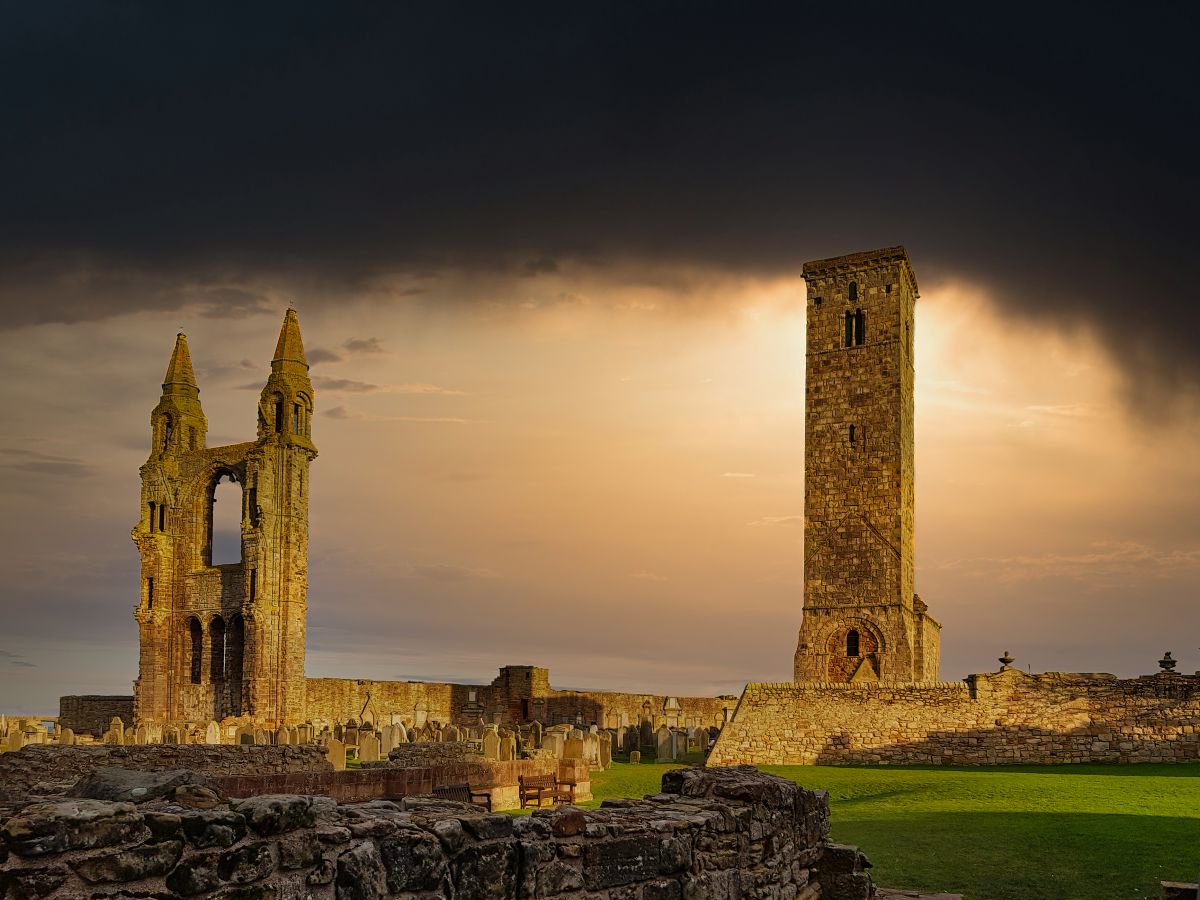
St. Rule Tower is named after Saint Rule, the saint who’s believed to have brought the relics of Saint Andrew from Greece to Scotland in the 4th century, and the tower built in his honour offers visitors some of the best views in the area. A climb up the narrow steps of the sandstone landmark gives you amazing views across the town, sea, and surrounding countryside, and if you’re a bit of a photo-fanatic, it’s a must-visit attraction.
The final highlight of Saint Andrews Cathedral is the graveyard, which is huge and definitely worth exploring. Part of the graveyard looks out onto St. Andrews Harbour, and there’s a gate at the bottom so you can head down to East Sands Beach, which is a must-do, especially in summer.
History
Built in 1158, the cathedral was the centre of Catholicism in Scotland for over 400 years until it was ransacked by a Protestant mob in 1559. From then on, it was repeatedly plundered for building materials during the construction of St. Andrews town, and then, at the end of the 16th century, the main tower collapsed, and what was once the biggest cathedral in Scotland was left to fall into ruin.
Fortunately, by the mid-1800s, historians recognised that the site should be preserved for future generations, and the site is now in the care of Historic Environment Scotland.
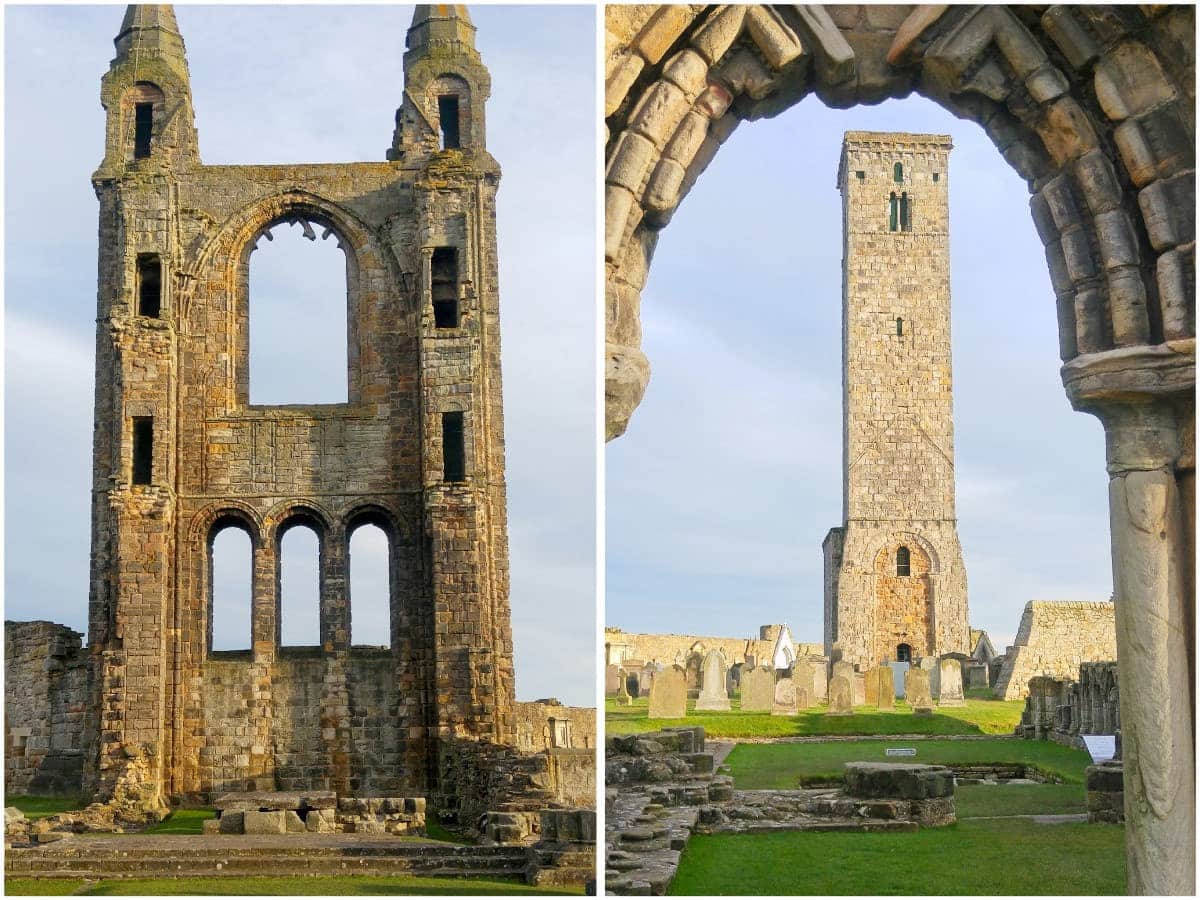
Book Tours in Scotland
Things to Do
Explore the Cathedral Ruins: One of the most enjoyable activities at St. Andrews Cathedral is exploring the ruins. With its history dating back to 1158, the cathedral offers a unique opportunity to delve into Scotland’s mediaeval religious past. You can wander through the remnants of what was once the largest cathedral in Scotland and imagine what life was like for the monks who lived there.
Climb St. Rule’s Tower: For an unmatched panoramic view of St. Andrews, climb the 156 steps to the top of St. Rule’s Tower. This 33-meter tower offers breathtaking views of St. Andrews and the surrounding countryside. It’s a bit of a climb, but the reward at the top is worth every step.
Visit the Cathedral Museum: Don’t miss the museum, which houses an impressive collection of mediaeval sculptures and other artefacts found on the site. You’ll see intricately carved masonry along with detailed information boards courtesy of HES that will tell you about the religious significance of each piece.
Join a Guided Tour: Participate in a guided tour to gain a deeper understanding of the cathedral’s history. A knowledgeable guide will walk you through the cathedral’s history, its construction, its destruction, and the various archaeological excavations that have taken place. To book a tour, take a look at the Get Your Guide website.
See the Cathedral Gravestones: The cathedral grounds are home to hundreds of gravestones of various ages and sizes. Walking around the site and reading the inscriptions is a fascinating way to spend an hour after visiting the rest of the cathedral.
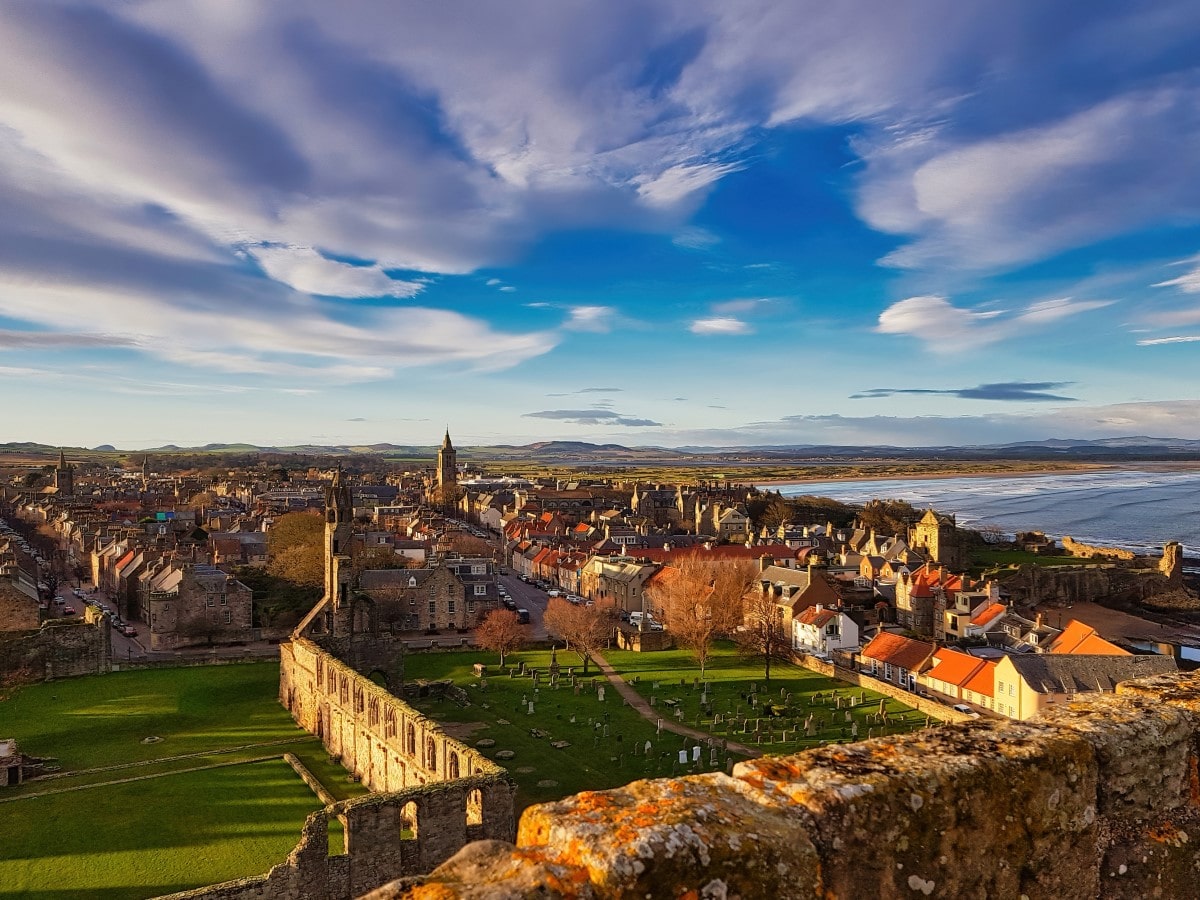
Things to Do Nearby
St. Andrews Castle. The Scores, St Andrews KY16 9AR, 4-minute walk
Ruined castles atop cliffs that overlook the North Sea During the 450 years that it was in use, it acted as a bishop’s palace, a prison, and a fortress. There is a museum inside the recently constructed visitor centre.
St. Andrews Aquarium. The Scores, St. Andrews, KY16 9AS, 12-minute walk.
An aquarium that faces the North Sea near West Sands Beach. The aquarium has a variety of enclosures on display that hold more than 100 different species of fish, as well as sharks, seals, and penguins.
St. Andrews Links, W Sands Rd., St. Andrews, KY16 9XL 14-minute walk.
The world’s oldest golf course St. Andrews Course was founded in the early 15th century. It is possible to walk alongside the course via West Sands Road. The clubhouse has a snack bar and a café.
West Sands Beach. W Sands Rd., St Andrews, KY16 9XL 13-minute walk.
An exceptionally large beach that is backed by St. Andrews Links. The beach juts out into the area where the River Eden flows into the North Sea at Out Head. Car parking and public toilets are located close to the beach.
St. Andrews Botanic Garden Canongate, St Andrews, KY16 8RT, 20-minute walk
A large botanic garden and greenhouses cover 18 acres in the heart of St. Andrews. There are more than 8,000 plant species to view, many of which are exotics that are rarely seen in Scotland. There are woodland walks, a play area, and a gift shop on site.
Protect Your Family From Scotland's Biting Midges
- Powerful, reliable protection for up to 8 hours
- Water- and sweat resistant
- Repels midges, mosquitoes, horse flies, sand flies, fleas and ticks
- Safe for use on adults, children over 30 months and pregnant women
- Non-sticky, moisturising with a pleasant fragrance
- Packaging may vary
Frequently Asked Questions
Can you go to St. Andrews Cathedral?
Yes, you can visit St. Andrews Cathedral, which is a landmark of historical and architectural significance. The cathedral was once the largest church in Scotland, and it still provides an incredible glimpse into the past.
The cathedral features a visitor centre where you can learn more about its history, and there are also guided tours available that offer deeper insights into the cathedral’s past. The cathedral grounds are open to the public, and you can walk around the ruins, visit the old graveyard, and climb up to the top of St. Rule’s Tower for an impressive view of the town and the surrounding coastline.
Is St. Andrews a city or town?
St. Andrews, located on the east coast of Scotland in Fife, is a town. It was designated a royal burgh in 1620 by James VI.
Why is St. Andrews Cathedral a ruin?
St. Andrew’s Cathedral fell into ruin after it was abandoned when Catholic mass was outlawed during the 16th-century Reformation.
What is St. Andrew the patron saint of?
St. Andrew is the patron saint of Scotland and Russia.







